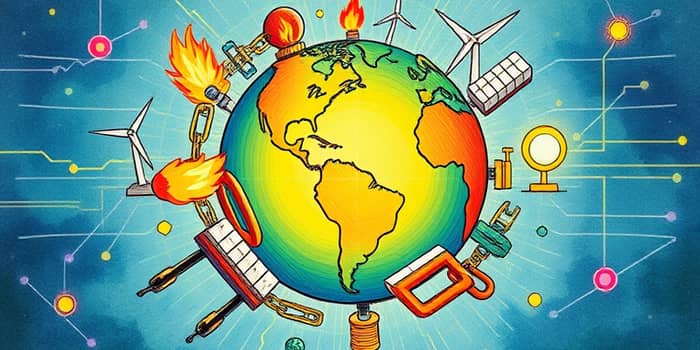
Energy markets around the world are witnessing an unprecedented surge in prices, driven by a complex interplay of soaring demand and persistent supply chain challenges. Consumers, businesses, and policymakers face a volatile landscape as costs climb, inflation ticks up, and energy security concerns intensify. Understanding the forces at play and identifying practical strategies for resilience are more critical than ever.
The global push toward electrification, combined with extreme weather events and rapid digitalization, has fueled record-breaking consumption levels. In 2024, energy demand grew by 2.2%, well above the decade’s annual average of 1.3%. This acceleration was driven by rising air conditioning use during heatwaves, expanded manufacturing output, and the proliferation of data centers powering artificial intelligence applications.
Electricity demand saw the most dramatic increase. In 2024, global electricity demand rose by 4.3%, the largest absolute annual jump outside post-recession recoveries. The power sector alone accounted for three-fifths of the total growth, underscoring the shift toward electrified solutions in industry and daily life.
On the supply side, renewables led the expansion, contributing 38% of new capacity in 2024. Natural gas followed at 28%, coal 15%, oil 11%, and nuclear 8%. Despite the rapid uptake of solar and wind, fossil fuels remain integral to meeting surging demand, creating a delicate balance in supply and price stability.
Energy prices have trended upward since 2021, initially spurred by post-pandemic recovery and tighter inventories. The conflict in Ukraine and subsequent sanctions on Russian exports further strained supplies in Europe, triggering record-high gas and electricity prices. In April 2025, the U.S. Henry Hub spot natural gas price reached $3.44 per million British thermal units, and it is forecast to climb to nearly $4.20/MMBtu by Q3 2025—almost double the level a year earlier.
Electricity prices, particularly in markets where gas sets the marginal cost, have mirrored this volatility. Regions heavily reliant on imported LNG are vulnerable to global shipping delays and price swings, while emerging economies contend with inflationary pressures that erode household purchasing power and threaten energy access for the most vulnerable.
Disruptions to global supply chains have amplified price pressures. A mix of geopolitical tensions, cyberattacks on logistics networks, and severe weather events has created bottlenecks at every link from production to delivery. Companies and consumers alike face delays, shipment cancellations, and unpredictable costs.
Key causes include:
The consequences of these shocks are severe:
In response to soaring prices and volatile supply, governments and businesses are accelerating the clean energy transition. In 2024, clean power generation exceeded 40% of global electricity, driven by record additions of solar and wind capacity. Today, 21 countries generate more than 15% of their electricity from solar alone, compared to just three nations five years ago.
Investment in LNG infrastructure continues to grow, though new terminals require years to become operational. Meanwhile, digitalization—using scenario-based planning, real-time monitoring, and predictive analytics—enhances grid flexibility and logistic resilience. Companies are diversifying suppliers, retrofitting facilities for dual-fuel capability, and adopting modular designs to reduce lead times.
While macro trends set the stage, individual actions can mitigate the impact of high energy costs and unstable supply. Businesses and households can build resilience through targeted measures:
For policymakers, reinforcing infrastructure, incentivizing clean energy deployment, and ensuring open markets are crucial. By prioritizing grid upgrades, cybersecurity standards, and workforce training, governments can foster an environment where innovation thrives and disruptions are contained.
The surge in energy prices amid supply chain disruptions highlights the interconnectedness of global markets and the fragility of existing systems. Yet, it also offers a catalyst for transformation—driving investments in renewables, digital tools, and resilient logistics. Stakeholders at every level can seize this moment to build a more secure, sustainable, and equitable energy future.
References













